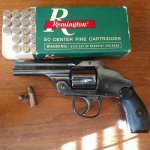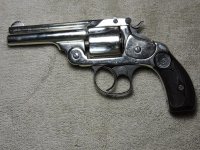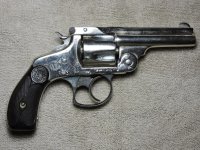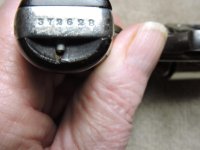My Grandfather's S&W top Break revolver has returned from gunsmith who gave it a clean bill of health. Is there a particular brand of .38 S&W ammo, I should look for? I estimate the revolver is about 130 years old so I want to find some ammo which will be safe to use in it. I would like to shoot maybe no more that 10 rounds and then put it in the back of the safe for the Grandkids. Suggestions Please.
You are using an out of date browser. It may not display this or other websites correctly.
You should upgrade or use an alternative browser.
You should upgrade or use an alternative browser.
.38 S&W Ammo Question
- Thread starter BigBoy99
- Start date
Register to hide this ad
old tanker
Member
There are plenty of folks here who will say standard loadings by US makers like Remington or Winchester are loaded down in deference to the many old break tops from the late 1800s still in circulation.
I can say for certain that you DO NOT want to shoot any of the hot loading from outfits like Buffalo Bore are any surplus British .380 ball, aka, .38-200.
My preference for the really old Smiths, Iver Johnsons and such, that were never proofed for smokeless is to load my own with black powder.
I can say for certain that you DO NOT want to shoot any of the hot loading from outfits like Buffalo Bore are any surplus British .380 ball, aka, .38-200.
My preference for the really old Smiths, Iver Johnsons and such, that were never proofed for smokeless is to load my own with black powder.
Attachments
Last edited:
gwpercle
Member
The ammo I used to shoot a few rounds in my grandfathers top break was Winchester , 38 Smith & Wesson , 145 grain Lead (RN) , X38SWP was printed on the end flap . All rounds fired and extracted easily .
My 38 S&W DA , 4th model , top break was manufactured after 1900 so use of smokeless ammunition , like the Winchester load , was OK .
Do Not shoot any high performance ammo designed for swing out cylinder revolvers ... the top break latch is the weak link and may not take the extra pressure .
The Winchester ammo I used showed no excessive pressure , the latch didn't come open and extraction of fired cases was easy .
The downside to the experience is the thin front and tiny rear sight , with my old eyes just staying on the target was tough ...my daughter shot it much better so I'm giving it to her after I'm through cleaning it up .
Gary
My 38 S&W DA , 4th model , top break was manufactured after 1900 so use of smokeless ammunition , like the Winchester load , was OK .
Do Not shoot any high performance ammo designed for swing out cylinder revolvers ... the top break latch is the weak link and may not take the extra pressure .
The Winchester ammo I used showed no excessive pressure , the latch didn't come open and extraction of fired cases was easy .
The downside to the experience is the thin front and tiny rear sight , with my old eyes just staying on the target was tough ...my daughter shot it much better so I'm giving it to her after I'm through cleaning it up .
Gary
There was nothing changed in the 4th Model from 1895 to 1909! The steel, the design, the parts remain exactly the same. Standard steel tensile strengths in excess of 30,000 psi were available shortly after the Civil War and were more than 3 times stronger than peak pressures produced by shooting standard 38 S&W. By the late 1800s, that strength was increased to 50,000 psi, making these old guns even better.
If a qualified gunsmith said it is ready to go, it will shoot "evil" smokeless powder just fine. I have shot thousands of rounds of 38 S&W through the years in my top-break S&Ws without issues. I found it absolutely safe to shoot standard modern loading. If one compares full load BP to Remington/Winchester 38 S&W, you will find significantly less felt recoil with smokeless. One last comment is the question if any ammunition manufacturer would make an almost obsolete caliber that was not thoroughly researched, tested, and loaded light knowing that much of the ammo will be shot in top-break revolvers in today's litigious world? They do not even warn top-break users about using their ammo on the box!
Can a part break on these old guns, certainly, but even a small spring can break, but not because of shooting smokeless. Everyone can do what they want, but the facts do not support their decisions to shoot only BP and never will, plus cleaning the outside is not good enough in humid climates, which makes a thorough cleaning necessary after shooting.
Here is some of my testing data on modern 38 S&W factory ammunition as compared to BP from both pre- and post-1900.
38 S&W 145RN Factory PPU . . . . . . . . . . . . . . . . . . . . . 599 fps
38 S&W 145RN Factory Winchester . . . . . . . . . . . . . . . . 615 fps
38 S&W 145RN Factory BP Winchester Pre-1900 . . . . . . .685 fps
38 S&W 145RN Factory BP Winchester Post-1900 . . . . . . 687 fps
38 S&W 145RN Factory BP Remington UMC . . . . . . . . . . 740 fps
If a qualified gunsmith said it is ready to go, it will shoot "evil" smokeless powder just fine. I have shot thousands of rounds of 38 S&W through the years in my top-break S&Ws without issues. I found it absolutely safe to shoot standard modern loading. If one compares full load BP to Remington/Winchester 38 S&W, you will find significantly less felt recoil with smokeless. One last comment is the question if any ammunition manufacturer would make an almost obsolete caliber that was not thoroughly researched, tested, and loaded light knowing that much of the ammo will be shot in top-break revolvers in today's litigious world? They do not even warn top-break users about using their ammo on the box!
Can a part break on these old guns, certainly, but even a small spring can break, but not because of shooting smokeless. Everyone can do what they want, but the facts do not support their decisions to shoot only BP and never will, plus cleaning the outside is not good enough in humid climates, which makes a thorough cleaning necessary after shooting.
Here is some of my testing data on modern 38 S&W factory ammunition as compared to BP from both pre- and post-1900.
38 S&W 145RN Factory PPU . . . . . . . . . . . . . . . . . . . . . 599 fps
38 S&W 145RN Factory Winchester . . . . . . . . . . . . . . . . 615 fps
38 S&W 145RN Factory BP Winchester Pre-1900 . . . . . . .685 fps
38 S&W 145RN Factory BP Winchester Post-1900 . . . . . . 687 fps
38 S&W 145RN Factory BP Remington UMC . . . . . . . . . . 740 fps
Licensed Gunsmith reccomendation?
So Bill,
This is the perfect opportunity to hear from a licensed gunsmith.
Since you just got the gun back from a gunsmith? and it was given a clean bill of health? Why not go with what the gunsmith recommends? What does the gunsmith have to say about cartridge recommendation? If the gunsmith says it's OK to shoot mild smokeless rounds then I'd say you're in a good place since he/she is liable if something happens after giving the gun a "clean bill of health". I would be very interested in hearing from the "licensed" gunsmith.
Also, can you please give us a few more details about the gun? Serial number range. Example: 75xxx.... Or perhaps post a photo?
Murph
So Bill,
This is the perfect opportunity to hear from a licensed gunsmith.
Since you just got the gun back from a gunsmith? and it was given a clean bill of health? Why not go with what the gunsmith recommends? What does the gunsmith have to say about cartridge recommendation? If the gunsmith says it's OK to shoot mild smokeless rounds then I'd say you're in a good place since he/she is liable if something happens after giving the gun a "clean bill of health". I would be very interested in hearing from the "licensed" gunsmith.
Also, can you please give us a few more details about the gun? Serial number range. Example: 75xxx.... Or perhaps post a photo?
Murph
Last edited:
Thanks for the ammo info. Below are a few pics. I'm a very cautious person and I just wanted to verify what I was told was correct. I fully realize that I don't want to shoot any "modern" smokeless powder ammo in it. It never hurts to double check.
Attachments
merl67
Member
This is the brand I use Prvi Partizan PPU .38 S&W 145grn LRN 50rd Box - AimSurplus, Llc. if I don't have any of my reloads it is perfectly safe to use.
Last edited:
Thanks for the ammo info. Below are a few pics. I'm a very cautious person and I just wanted to verify what I was told was correct. I fully realize that I don't want to shoot any "modern" smokeless powder ammo in it. It never hurts to double check.
??? It's perfectly fine to shoot modern smokeless cartridges in it.
I've been using Winchester in mine (it's what I had around)

Is that Silver finish? Or is the light playing tricks?
Murph
I have no idea if silver. I just assumed it was nickle plated. Is there some way to easily tell?
Finish
Bill,
I was referring to the delcrossv gun photo. It's rare but sometimes you can find a double action that is Silver plated. I have an early model 2 double action 32 topbreak that is Silver plated with the name "KAISER" fancy and period engraved on the backstrap with Parakeet black hard rubber grips. A factory letter however confirmed that the Silver plate & engraved name were aftermarket additions. I believe Silver was a "Status" plating. There is no advantage to Silver over Nickel plate except for the Status quo. The owner had money and obviously related to the Kaiser family but I can't prove it except for the Silver finish and the period engraving.
Murph
Bill,
I was referring to the delcrossv gun photo. It's rare but sometimes you can find a double action that is Silver plated. I have an early model 2 double action 32 topbreak that is Silver plated with the name "KAISER" fancy and period engraved on the backstrap with Parakeet black hard rubber grips. A factory letter however confirmed that the Silver plate & engraved name were aftermarket additions. I believe Silver was a "Status" plating. There is no advantage to Silver over Nickel plate except for the Status quo. The owner had money and obviously related to the Kaiser family but I can't prove it except for the Silver finish and the period engraving.
Murph
Sorry, it's nickel+bad lighting.
Similar threads
- Replies
- 2
- Views
- 95





